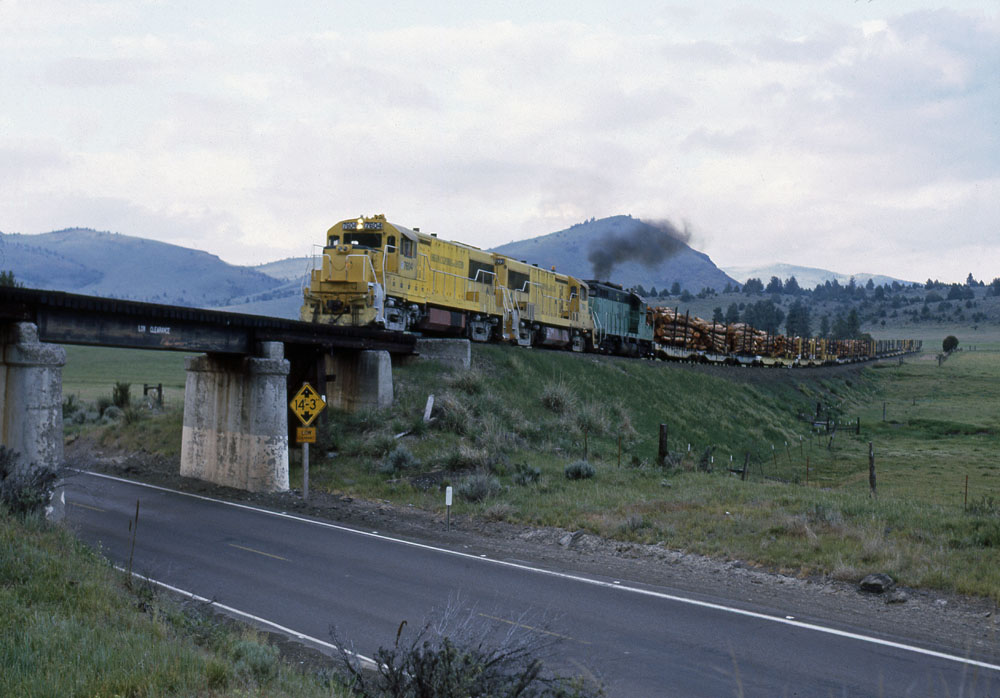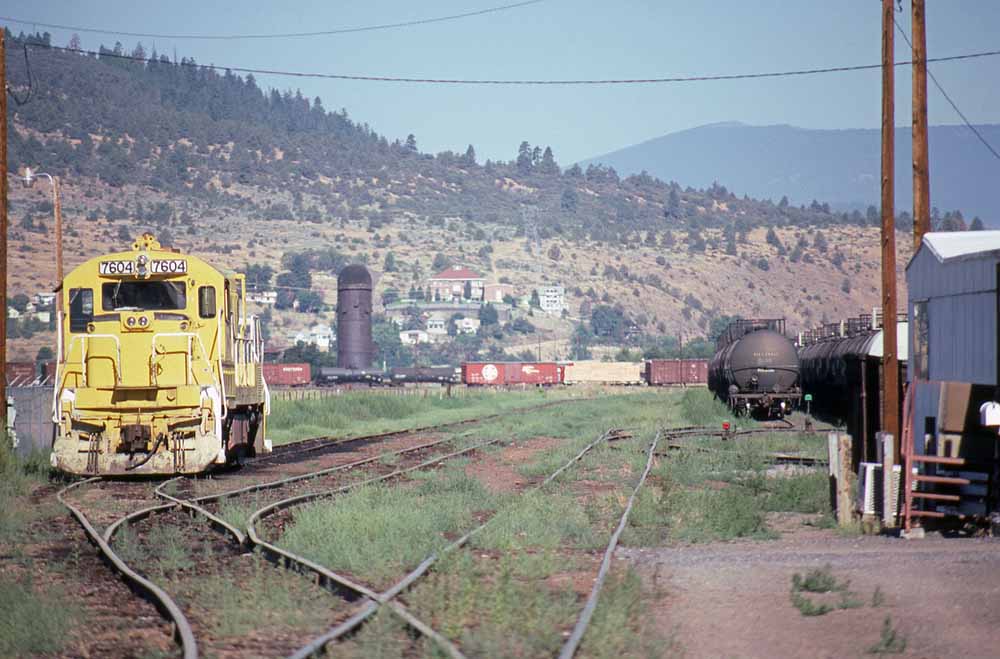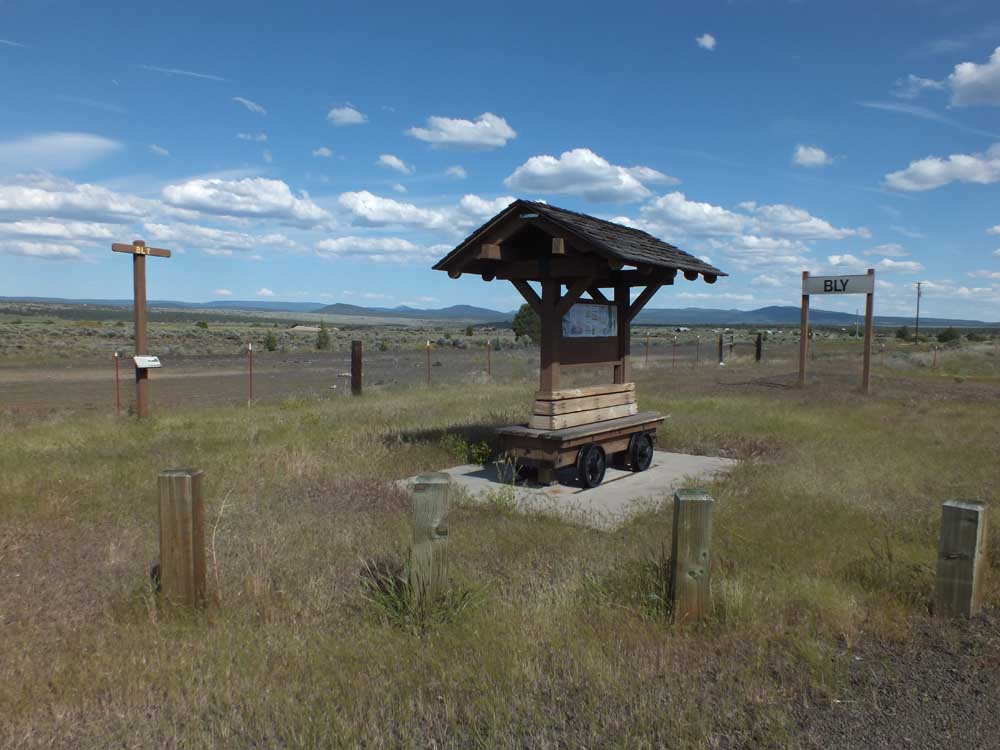|
Oregon California & Eastern Railroad History Page 4- Decline and Abandonment, 1985-1993 |
|
|
 |
|
An eastbound OC&E freight with several log loads probably bound for the Bly mill. C.G. Heimerdinger Jr. photo.
|
|
Carloadings handled by the OC&E finally stabilized at around 8,000 loads a year. Carload totals for
1989 showed a total of 8,303 loads handled by the railroad, consisting of three carloads of potatoes,
eight carloads of scrap, 678 carloads of asphalt switched into WITCO in Klamath Falls, and 7,614 loads
of logs. Operations saw a similar decline, with the railroad making only three runs a week to the Bly
in the last years of operation. Employment likewise dropped, from 38 in 1982 down to 18 in the late
1980s. Motive power needs also dropped, and as a result all but one of the eight Baldwin diesels owned
by the OC&E and the Woods Line were gone by the mid-1980s. By the late 1980s Weyerhaeuser had basically achieved the beginnings of the even-age management that had led the company to buy the OC&E in the first place, but this resulted in most of the company's forests now being very young and needing years to decades before they would be ready to harvest. Weyerhauser tried compensating for the loss of their own timber by starting to bid on U.S. Forest Service timber sales, but the company's lack of experience in that realm caused it to lose out badly to Roseburg Forest Products on a couple of large sales that lay adjacent to the east side unit. By the spring of 1990 Weyerhaeuser decided to scale back operations at Klamath Falls to adjust to the new realities. The company laid off a full thirty percent of the workforce at the Klamath Falls mill, followed closely by a decision to eliminate the OC&E and the Woods Railroad. The last train on the Woods Railroad ran on 2 February 1990, and the last OC&E log train to Bly ran on Sunday, 29 April 1990. The following day the OC&E delivered the last logs brought in by rail to the Klamath Falls sawmill, and on Tuesday 1 May the railroad operated a clean up run to return all empty log cars from the last run, plus all log cars stored in sidings along the line, and some other equipment into storage at Sycan. A number of other cars remained in storage at Bly. Oregon's last logging railroad fell silent after the two locomotives returned to Klamath Falls. Weyerhaeuser hired a consultant to evaluate its options with the railroad. WITCO still had to be switched, and during the spring and summer months the railroad fired up one of the two locomotives stored in Klamath Falls a couple times a week to shuttle the tank cars between WITCO and the interchanges with the BN and SP. Meanwhile, some local groups, led by the Great Western Railroad Museum, started efforts to preserve the railroad as a potential tourist attraction for the area. The museum submitted three bids to Weyerhaeuser for all or part of the OC&E, but the company rejected all of them by March 1991. The museum appealed the rejection all the way to the very top of Weyerhaeuser with no avail.  Last gasp of the OC&E. The #7604 sits in Klamath Falls in between switching the WITCO tank cars seen at left on 5 August 1990. Jerry Lamper photo. Weyerhaeuser finally elected to liquidate the railroad in mid-1991. The company moved the three ex-BN GP-9 type locomotives and three cabooses north to the large Weyerhaeuser operations out of Longview, Washington. The railroad placed the rest of the equipment, consisting of the five M-K diesels, the two M-K slugs, two ex-SP cabooses, 311 log cars, two wooden snowplows, six fire service tank cars, eleven ballast hoppers, and other miscellaneous equipment were up for sale, with bids due by 30 September. Weyerhaeuser re-activated the railroad one last time, and between 5 September and 25 September 1991 the company operated a total of ten trains to bring all equipment stored at Sycan and Bly down into Klamath Falls. The first trains run moved all the cars stored in Bly to Sycan, and then the crews built 45-car long trains in Sycan for the trip to Klamath Falls so that they would avoid having to double the trains through the switchbacks. The final OC&E train over the old mainline ran on 25 September 1991 to bring the final 79 cars from Sycan, all old log cars riding on friction bearing trucks, into Klamath Falls. The railroad shortly thereafter filed an application to abandon the railroad with the Interstate Commerce Commission. Weyerhaeuser located buyers for the M-K locomotives, which left the property in 1992. An initial deal to sell the log cars to the Kiamichi Railroad in Oklahoma fell through, and in the end Weyerhaeuser scrapped the bulk of the log cars, along with most of the other railroad equipment, in Klamath Falls, though a few pieces of equipment got saved by various entities in the region. The OC&E also had a fleet of 150 boxcars leased from BRAE corp, and after the demise of the railroad Weyerhaeuser transferred the lease to other railroads the company owned. The Interstate Commerce Commission granted permission to abandon the railroad in December 1991, and Weyerhaeuser auctioned the railroad off early the following year. Southern Pacific got the contract to scrap the railroad, and commenced scrapping operations in August 1992. SP crews commenced salvage work at the very ends of the system at Bly and 500 transfer, and work progressed until snows shut the project down that winter. SP finished scrapping the rest of the railroads during the spring and summer of 1993. The great mill in Klamath Falls that had been fed by the OC&E and Weyerhaeuser's network of private logging railroads finally closed in May 1992, and in 1996 Weyerhaeuser exited Klamath Falls altogether after selling all timberlands in the area to U.S. Timberlands and the remaining operations of the Klamath Falls plant (particleboard, plywood, and hardboard) to Collins Products Company. Oregon State Parks eventually acquired the OC&E and Woods Railroad grades and converted them into a recreational trail. |
 |
|
Bly trailhead of the OC&E/Woods Line state trail. |
|
|